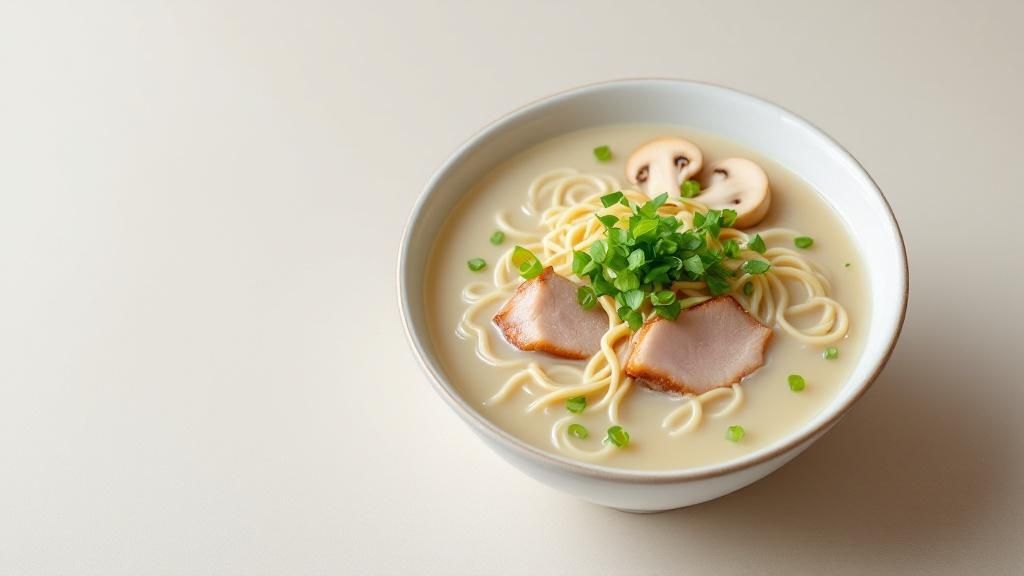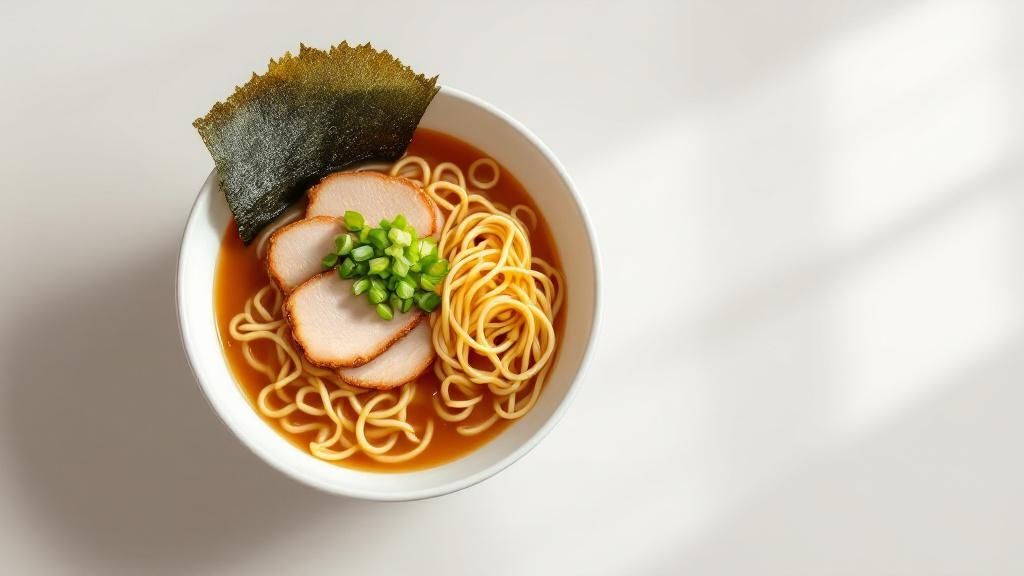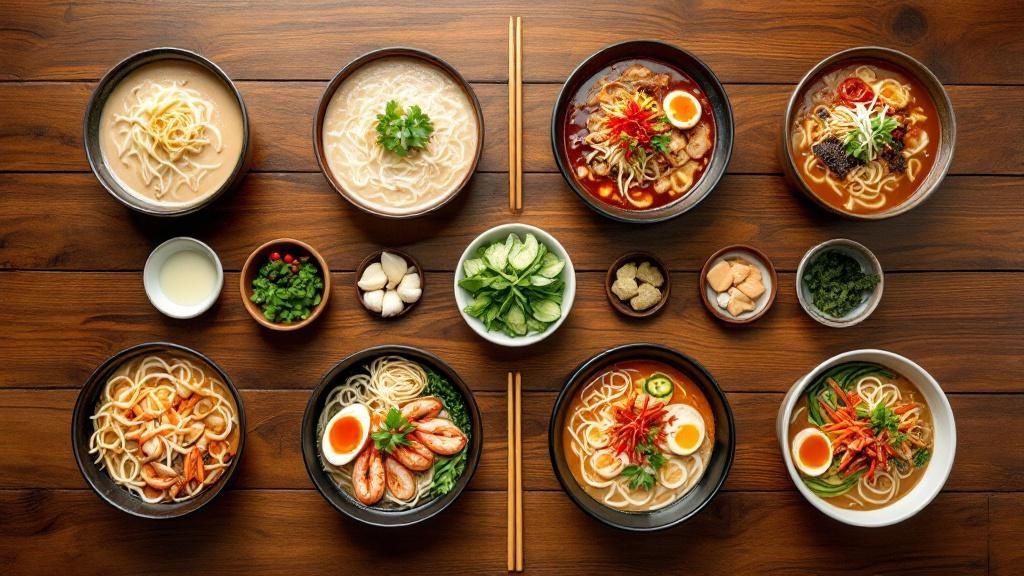Beyond the Broth: A Journey Into the World of Ramen
Ramen is more than just noodle soup; it’s a universe of complex flavors, regional pride, and culinary art. While many are familiar with instant noodles, the world of authentic ramen offers a staggering diversity that can seem overwhelming. From the cloudy, collagen-rich broth of Tonkotsu to the clear, refined elegance of Shio, each bowl tells a unique story shaped by its ingredients and history. Understanding the fundamental types of ramen is the first step to discovering what you truly love about this iconic Japanese dish.
This guide serves as your definitive passport to exploring the 8 essential styles that define Japan's most beloved food. We will move beyond surface-level descriptions to provide a detailed breakdown of each variety, covering its core components, distinct flavor profile, and historical origins. Whether you're a seasoned ramen enthusiast aiming to deepen your knowledge or a curious newcomer ready for your first authentic bowl, this list will equip you to navigate any menu with confidence. Prepare to find your next obsession as we slurp our way through a delicious journey, complete with practical tips for crafting an incredible at-home experience.
1. Tonkotsu Ramen
Tonkotsu, meaning "pork bone" in Japanese, is arguably one of the most iconic and beloved types of ramen across the globe. Originating from the Hakata district of Fukuoka city on Kyushu island, its defining feature is a luxuriously rich, opaque broth. This creamy, almost milky consistency is achieved by simmering pork bones, fat, and collagen for an extended period, often upwards of 12 hours, until the marrow and collagen emulsify into a deeply savory, umami-packed liquid.

The resulting broth has a profound pork flavor that coats the noodles and every topping, making each bite an intensely satisfying experience. This style was popularized by traditional Hakata ramen shops and later brought to international fame by chefs like Shigemi Kawahara of the Ippudo chain and David Chang of Momofuku, who introduced modernized interpretations to a Western audience. If you want to dive deeper into its history and variations, you can explore the many different types of ramen in Japan to see how Tonkotsu compares.
How to Best Enjoy Tonkotsu Ramen
To fully appreciate the richness of Tonkotsu, consider these practical tips:
- Order Kaedama: Because the thin, straight noodles typical of Hakata-style ramen cook quickly, many shops offer a kaedama system. This is an extra serving of noodles you can order to add to your remaining broth, ensuring you don't waste a drop.
- Balance the Richness: The broth is incredibly decadent. To avoid overwhelming your palate, pair your bowl with lighter sides like pickled ginger (beni shoga) or a simple gyoza appetizer, rather than something equally heavy like fried chicken (karaage).
- Eat It Quickly: Tonkotsu is best enjoyed piping hot. The heat keeps the fats in the broth emulsified; as it cools, the texture can change and feel less pleasant. Slurp away without hesitation to get the full, intended flavor profile.
2. Shoyu Ramen
Shoyu, the Japanese word for soy sauce, is the star of this classic ramen style, which is considered the oldest and most traditional of them all. Originating in Tokyo, Shoyu ramen features a clear, brown broth that is light yet deeply flavorful. The base is typically a chicken or vegetable stock, sometimes blended with pork or seafood, and seasoned with a soy sauce tare. This creates a taste that is savory, tangy, and nuanced without the heavy, mouth-coating richness found in other types of ramen.

This foundational style dates back to Rairaiken, the shop in Asakusa, Tokyo, credited with popularizing ramen in 1910. Its refined flavor profile makes it a versatile canvas for a wide array of toppings, from sliced chashu pork and bamboo shoots to nori and a soft-boiled egg. While classic Tokyo-style shoyu is light and clean, variations like Ramen Jiro's version are known for being intensely heavy and loaded with pork fat and garlic, showcasing the style's adaptability.
How to Best Enjoy Shoyu Ramen
To get the most out of this traditional ramen experience, here are some practical suggestions:
- Taste the Broth First: Before adding any extra condiments, take a spoonful of the broth on its own. This allows you to appreciate the subtle, layered flavors that the chef has carefully balanced. Adding too much chili oil or pepper upfront can easily overwhelm its delicate profile.
- Opt for Lighter Pairings: Because the broth is not as rich as Tonkotsu or Miso, it pairs wonderfully with classic sides that won't overpower it. A simple order of pan-fried gyoza or a small side salad complements the meal perfectly.
- Ideal for a Lighter Meal: Shoyu ramen is an excellent choice when you're craving ramen but don't want the food coma that can follow heavier styles. Its less fatty composition makes it a refreshing option for lunch or a satisfying yet manageable dinner.
3. Miso Ramen
Miso ramen is a hearty, complex style that uses fermented soybean paste, or miso, as its primary seasoning base. Originating in Sapporo, Hokkaido, Japan's northernmost island, this ramen was ingeniously developed to combat the region's harsh, cold winters. The miso provides a deep, savory, and nutty flavor profile that is both robust and comforting. Unlike the singular focus of tonkotsu, miso ramen's broth can be made with various bases, including pork, chicken, or even vegetable stock, giving it incredible versatility.

The creation is famously attributed to Morito Omiya of the Sapporo restaurant Aji no Sanpei in the 1950s, who wanted to create a more nourishing and flavorful noodle soup. This style quickly became a hallmark of Hokkaido regional cuisine and is now a staple in ramen shops worldwide. The broth is characteristically opaque and thick, with a profound umami punch that lingers on the palate. If you want to explore the key ingredient further, you can elevate your dishes with low-sodium miso paste to understand its nuances.
How to Best Enjoy Miso Ramen
To get the most out of your Miso Ramen experience, keep these tips in mind:
- Embrace the Toppings: Miso ramen is famously paired with sweet corn and a pat of butter, which melts into the broth to add a layer of creamy sweetness that balances the miso's saltiness. Other classic additions include stir-fried bean sprouts, ground pork, and scallions.
- Ask About the Miso: Not all miso is the same. Shops may use white miso (shiro), red miso (aka), or a custom blend (awase). Ask your server about their blend to better understand the flavor profile; red miso is funkier and saltier, while white miso is milder and sweeter.
- Pair with a Cold Beer: The robust, savory flavor of Miso ramen pairs exceptionally well with a crisp, cold Japanese lager. The beer's clean finish helps cut through the richness of the broth, cleansing your palate between bites and making the entire meal more refreshing.
4. Shio Ramen
Shio, which translates to "salt" in Japanese, is the oldest and often considered the most refined of the primary ramen seasonings. This style is defined by its light, clear broth seasoned with a simple salt-based tare. Unlike its richer counterparts, shio ramen takes a minimalist approach, allowing the nuanced flavors of the underlying stock, typically made from chicken, dashi, or vegetables, to take center stage. Its transparent, pale-golden appearance is a testament to its delicate and clean flavor profile.
. Minimalist approach. Stock is often chicken, seafood, or vegetables.
- Examples: Hanamaru in Tokyo, coastal Japanese shops (local seafood), high-end ramen establishments.
- Tips: Appreciate the subtlety (don't rush), pairs well with seafood toppings, best with high-quality ingredients, ideal for low-calorie option.
- Popularized By: Traditional Japanese coastal regions, high-end Tokyo ramen shops, minimalist ramen philosophy advocates.
Let's start writing:
H2 Heading:
## 4. Shio Ramen
First Paragraph (Introduction):
- Introduce Shio ramen, meaning "salt".
- Mention it's the oldest and most refined seasoning.
- Describe the broth: light, clear, seasoned with salt-based tare.
- Contrast with richer styles (like Tonkotsu).
- Emphasize how it lets the stock (chicken, dashi, vegetables) shine.
- Mention its appearance: transparent, pale-golden.
Image:
- Insert the provided image URL.

Second Paragraph (History/Context):
- Talk about its origins and popularization.
- Mention traditional coastal regions using local seafood for the stock.
- Bring in high-end Tokyo shops like Hanamaru for refined versions.
- Connect it to a minimalist ramen philosophy.
- Mention it's a fundamental style and a great way to understand the different types of ramen.
H3 Heading for Tips:
### How to Best Enjoy Shio Ramen
Bulleted List of Tips:
- Tip 1: Appreciate the Nuances: "Appreciate the subtlety—don't rush". Frame this as taking your time to savor the delicate flavors. Advise against adding too many strong condiments immediately.
- Tip 2: Choose Toppings Wisely: "Pairs well with seafood toppings". Elaborate on this. Suggest toppings like grilled scallops, shrimp, or delicate white fish. Mention that light toppings like chicken chashu or menma also work well, as they don't overpower the broth.
- Tip 3: Savor High-Quality Ingredients: "Best when ingredients are highest quality". Explain that because the broth is so simple, the quality of each component (stock, noodles, toppings) is crucial and highly noticeable. It's a true test of a chef's skill.
Word Count Check:
- Intro paragraph: ~60 words.
- Context paragraph: ~60 words.
- Tips intro: ~10 words.
- Tips list: ~35 words per tip * 3 = ~105 words.
- Total: 60 + 60 + 10 + 105 = ~235 words. This fits perfectly within the 216-324 word range.
Final Review:
- Structure: H2, Para 1, Image, Para 2, H3, Bulleted list. - Looks correct.
- Formatting: Short paragraphs, H3 for tips, bullet points, no em dashes. - Correct.
- Tone: Informative. - Correct.
- Content: Matches the provided details, actionable tips, specific examples. - Correct.
- SEO: "types of ramen" included naturally. - Correct.
- Word count: Within range. - Correct.
The plan is solid. I will now generate the final response based on this thought process.## 4. Shio Ramen
Shio, which translates to "salt" in Japanese, is the oldest and often considered the most refined of the primary ramen seasonings. This style is defined by its light, clear broth seasoned with a simple salt-based tare. Unlike its richer counterparts, shio ramen takes a minimalist approach, allowing the nuanced flavors of the underlying stock, typically made from chicken, dashi, or vegetables, to take center stage. Its transparent, pale-golden appearance is a testament to its delicate and clean flavor profile.

The elegance of shio ramen lies in its simplicity, making it a true test of a chef's skill. This style was born in Japan’s coastal regions, where fresh seafood and seaweed were used to create subtle yet complex broths. Today, it's celebrated by high-end Tokyo shops and advocates of a minimalist ramen philosophy who believe the purest form highlights the quality of each ingredient. For newcomers exploring the different types of ramen, shio offers a foundational and less-intense introduction compared to heavier, more complex bowls.
How to Best Enjoy Shio Ramen
To fully appreciate the delicate balance and subtle complexity of shio ramen, keep these practical suggestions in mind:
- Appreciate the Nuances First: Before adding any condiments, take a moment to sip the broth on its own. Shio's flavor is subtle and layered, and rushing or immediately adding chili oil can mask the chef's intended taste profile.
- Choose Complementary Toppings: The light broth pairs beautifully with equally delicate toppings. Opt for lean chicken chashu, tender bamboo shoots (menma), or seafood like grilled scallops or shrimp. These enhance the soup rather than overpowering it.
- Prioritize Quality: Because there are no heavy flavors to hide behind, the quality of each component is paramount. A great shio ramen depends on a masterfully prepared stock and fresh, high-quality noodles and toppings, making it a true connoisseur's choice.
5. Tsukemen
Tsukemen, which translates to "dipping noodles," offers a deconstructed and interactive take on the classic ramen experience. Instead of being served together in one bowl, the noodles and broth are presented separately. Diners receive a portion of thick, chewy noodles, often served cold or at room temperature, alongside a bowl of intensely concentrated, hot dipping broth. The broth is much richer and saltier than a standard ramen soup, designed to cling to the noodles with each dip.
This unique style was pioneered by Kazuo Yamagishi, the founder of the legendary Taishoken shop, and has since become a cornerstone of modern ramen culture. Establishments like Rokurinsha, famous for its long queues at Tokyo Station, and the innovative Fuunji have elevated Tsukemen to an art form. The separation of components allows diners to control the temperature and flavor intensity of every single bite, making it a distinct and engaging meal. While indulgent, Tsukemen is part of a broader culinary tradition; you can learn more about how Japanese food stays healthy despite such rich dishes.
How to Best Enjoy Tsukemen
To get the most out of this interactive dining style, keep these practical tips in mind:
- Dip, Don't Soak: To properly coat the noodles without making them overly salty, dip only the bottom half or two-thirds of your noodle bundle into the broth. This ensures a perfect balance of noodle texture and concentrated broth flavor in each mouthful.
- Ask for a Hot Stone: The dipping broth can cool down as you eat. Many specialty Tsukemen shops offer a yaki-ishi, or a super-heated stone, that they can place in your bowl to bring the broth back to a bubbling hot temperature.
- Finish with Soup-Wari: Don't let that intensely flavorful broth go to waste. After you've finished your noodles, ask the staff for soup-wari. They will add a light, dashi-based broth to your bowl, diluting the concentrate into a perfectly palatable soup for you to sip and finish your meal.
6. Tantanmen
Tantanmen is a fiery and flavorful ramen that showcases the brilliant fusion of Japanese and Chinese culinary traditions. Its roots lie in Sichuan dan dan mian (dan dan noodles), but the Japanese interpretation has evolved into a distinct soupy ramen style. The defining characteristic of Tantanmen is its broth, a rich and nutty concoction made from sesame paste (nerigoma), often blended with miso or soy sauce, and infused with spicy chili oil (rayu). This creates a creamy, savory, and aromatic soup with a satisfying kick.
The dish is typically topped with seasoned ground pork, chopped scallions, and sometimes preserved vegetables like zha cai. This fusion style was popularized through Japanese-Chinese restaurants (chuka ryori) and has seen significant regional adaptations, such as the unique, often soup-less variations found in Hiroshima. Modern ramen chefs continue to experiment with Tantanmen, making it a dynamic and exciting choice for those who appreciate bold, complex flavors. It’s an essential entry in any exploration of the different types of ramen.
How to Best Enjoy Tantanmen
To get the most out of this spicy and savory ramen, keep these tips in mind:
- Mix It Thoroughly: Before taking your first bite, use your chopsticks and spoon to mix everything together. The ground meat, sesame paste, and chili oil often settle at the bottom. A good stir ensures every noodle is coated in the rich, flavorful broth for a balanced taste experience from start to finish.
- Start with Mild Spice: Tantanmen's heat can vary significantly between shops. If you're unfamiliar with a particular restaurant's version or sensitive to spice, it's wise to order a mild or standard spice level. You can often add more chili oil later if you want an extra kick.
- Pair with a Cool Drink: The nutty and spicy flavors of the broth are beautifully complemented by a crisp, cold beverage. A light Japanese lager, a cold oolong tea, or even a simple glass of iced water can help cleanse the palate between bites and balance the dish's intensity.
7. Mazesoba
Mazesoba, which translates to "mixed noodles," is a vibrant and modern ramen style that breaks from tradition by completely omitting the broth. Originating in Nagoya as "Taiwan Mazesoba" but popularized across Tokyo's experimental ramen scene, this dish centers on thick, chewy noodles served with a concentrated, savory sauce at the bottom of the bowl. The focus shifts from the soup to the intense interplay between the noodles, the rich tare (sauce), aromatic oils, and a colorful array of toppings. It is one of the more unique types of ramen, offering a dry, saucy experience more akin to a pasta dish.
The result is an explosion of flavor and texture in every bite, as each component is designed to be mixed together by the diner. This interactive style has been championed by youth-oriented shops and innovative chefs who see it as a canvas for creativity, leading to countless variations. Modern Tokyo ramen shops and specialty chains like Menya Kokoro have brought Mazesoba to international attention, celebrating its bold, customizable nature. For those interested in trying to create similarly bold flavors at home, there are many easy Japanese recipes to explore that capture this spirit.
How to Best Enjoy Mazesoba
To get the most out of this unique, brothless ramen experience, follow these practical tips:
- Mix It Thoroughly: This is the most crucial step. Use your chopsticks and spoon to mix everything together for at least 20-30 seconds. The goal is to evenly coat every noodle strand with the sauce, oil, and minced toppings to create a single, harmonious flavor profile.
- Add a Raw Egg Yolk: Many classic Mazesoba bowls come with a raw egg yolk. When mixed in, it adds a luxurious, creamy texture that mellows the saltiness of the sauce and binds all the ingredients together, creating an incredibly rich mouthfeel.
- Customize with Condiments: Tables at Mazesoba shops are often stocked with condiments like vinegar, chili oil (rayu), and ground pepper. Adding a splash of vinegar partway through your meal can cut through the richness and brighten the flavors, offering a new taste experience.
- Ask for Oimeshi: After you've finished your noodles, you'll likely have a delicious, concentrated sauce left at the bottom of your bowl. Many shops offer a small scoop of complimentary rice (oimeshi) to mix into the remaining sauce, ensuring not a single drop of flavor goes to waste.
8. Kitakata Ramen
Kitakata ramen is a cherished regional specialty hailing from the city of Kitakata in Fukushima Prefecture, standing alongside Sapporo and Hakata as one of Japan's three great ramen towns. Its defining characteristic is a light, clear broth crafted from a delicate balance of pork bones and niboshi (small dried sardines). This combination results in a remarkably clean yet deeply savory flavor profile that is both refreshing and complex, a stark contrast to the heavier, opaque broths of other popular types of ramen.
The noodles are just as distinctive: they are flat, wide, and very curly, with a high water content that gives them a wonderfully soft yet chewy texture. This unique style was born from the city's history of sake and soy sauce production, with many workers seeking a hearty, comforting meal early in the day. This tradition gave rise to "Asa-Ra" or "morning ramen," a culture that remains a cornerstone of Kitakata life today, with famous shops like Bannai Shokudo serving bowls to locals and tourists from as early as 7 a.m.
How to Best Enjoy Kitakata Ramen
To truly get the most out of this unique regional dish, follow these practical tips:
- Embrace the Morning Ramen Culture: For the most authentic experience, try visiting a ramen shop in Kitakata city in the morning. Enjoying a bowl for breakfast is how the style was originally popularized and remains the best way to immerse yourself in the local food culture.
- Savor the Noodle Texture: The flat, hand-crumpled noodles are the star of the show. Take a moment to appreciate their unique chewiness and how they catch the subtle broth. Don't rush; let the unique mouthfeel be part of the experience.
- Appreciate the Subtle Flavors: Unlike Tonkotsu or Miso, Kitakata ramen’s charm is in its subtlety. Pay attention to the gentle umami from the niboshi and the clean pork essence. Avoid adding too many strong condiments at first, as they can easily overpower the delicate broth.
8 Types of Ramen Comparison
| Ramen Type | Implementation Complexity 🔄 | Resource Requirements ⚡ | Expected Outcomes 📊 | Ideal Use Cases 💡 | Key Advantages ⭐ |
|---|---|---|---|---|---|
| Tonkotsu Ramen | High; long 12-20 hour bone broth cooking | High; requires pork bones, skillful simmering | Rich, creamy, intensely savory broth | Premium dining, hearty meals | Deep flavor, popular worldwide, high protein |
| Shoyu Ramen | Medium; careful balance of soy sauce | Moderate; soy sauce, chicken/vegetable stock | Clear, light, refined flavorful broth | Light lunches, subtle palate | Lighter, ingredient clarity, lower calories |
| Miso Ramen | Medium; requires quality miso selection | Moderate; fermented miso, ground pork, vegetables | Robust, umami-rich, balanced broth | Cold weather, warm comforting dishes | Complex umami, probiotic benefits, warming |
| Shio Ramen | Medium to High; delicate seasoning | Moderate; high quality seafood/chicken stock | Clear, minimalist, clean and light broth | Calorie-conscious, refined taste buds | Lowest calorie, highlights ingredient purity |
| Tsukemen | High; separate broth and noodles prep | High; thick noodles, concentrated broth | Intense, hot dipping broth, interactive | Interactive dining, flavor control | Noodles stay firm, customizable dipping |
| Tantanmen | Medium; blending sesame, miso, chili | Moderate; sesame paste, chili oil, ground pork | Creamy, spicy, nutty broth | Fans of spice and fusion flavors | Unique fusion flavor, satisfying spice level |
| Mazesoba | Low to Medium; no broth but thorough mixing | Low; concentrated sauce, thick noodles | Intense, concentrated sauce-coated noodles | Quick meals, texture-focused eating | Customizable, intense flavors, less messy |
| Kitakata Ramen | Medium; pork and dried sardine broth | Moderate; pork bones, niboshi (dried sardines) | Light, umami-rich, clear broth | Regional specialty, morning meals | Authentic regional flavor, light yet savory |
From Our Guide to Your Bowl: Start Your Ramen Adventure
You have now journeyed through the rich and diverse landscape of Japanese ramen. From the creamy, pork-infused depths of Tonkotsu to the nutty, spicy complexity of Tantanmen, it’s clear that "ramen" is not a single dish but a universe of culinary expression. We've explored how a simple bowl of noodles and broth can tell a story of regional pride, ingredient artistry, and generations of refinement. Understanding these distinct types of ramen is the first, most crucial step in elevating your appreciation from a casual diner to a true connoisseur.
The most important takeaway is that flavor is built from the ground up, starting with the tare (flavor base) and the broth. Whether it's the foundational saltiness of shio, the deep umami of shoyu, or the fermented funk of miso, this core combination dictates the entire experience. Recognizing this empowers you to order with intention, identifying the profiles that truly resonate with your palate.
Your Next Steps in Ramen Exploration
Armed with this knowledge, your ramen journey is just beginning. The path forward is an exciting one, filled with delicious discovery. Here’s how you can transform what you’ve learned into tangible, tasty experiences:
- Become a Local Explorer: Seek out a dedicated ramen-ya (ramen shop) in your area. Instead of ordering your usual, try a new style from this guide. Ask the staff about their specialty or what makes their Miso or Shio ramen unique. This is the best way to experience authentic preparation.
- Host a Ramen Tasting: Invite friends over and assign each person a different instant ramen kit to prepare, or challenge yourself to make two different broths from scratch. This allows you to compare styles like the clear, delicate Shio against the bold, cloudy Tonkotsu side-by-side.
- Master the Toppings: Elevate any bowl, whether instant or homemade, by focusing on high-quality toppings. Practice making your own ajitama (marinated soft-boiled eggs), char siu pork, or spicy chili oil. Toppings are where you can inject your personal creativity.
Bringing the Ramen-Ya Experience Home
For those eager to recreate these authentic flavors in their own kitchen, the possibilities are endless. Making a traditional Tonkotsu broth can be an all-day affair, but modern tools can significantly speed up the process. If you're eager to try making ramen at home, consider exploring methods for faster preparation, such as using an Instant Pot for quick ramen broth. This allows you to achieve a rich, flavorful base in a fraction of the time, making weeknight ramen a delicious reality. Mastering these types of ramen at home isn't just about cooking; it’s about connecting with a beloved aspect of Japanese culture and creating deeply satisfying meals for yourself and your loved ones.
Your adventure into the world of ramen starts with a single bowl. Which will it be?
Ready to start your culinary experiments? Visit Buy Me Japan to find authentic, high-quality ingredients, from specialty miso pastes to artisanal shoyu and premium noodles. Bring the true taste of Japan to your kitchen and begin crafting your perfect bowl of ramen today.




Share:
Top Japanese Makeup Removers of 2025 | Gentle & Effective
8 Best Japanese Face Wash Options for Flawless Skin (2025)